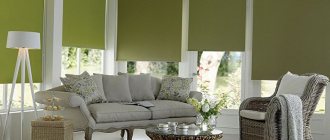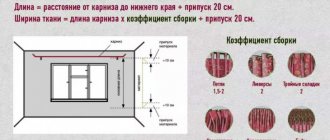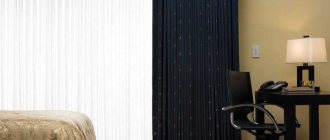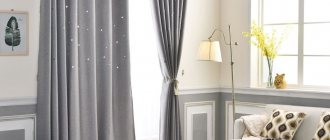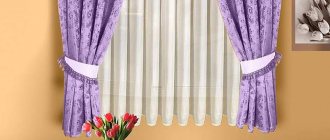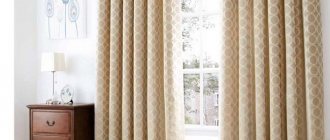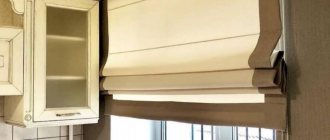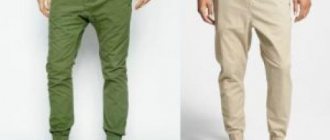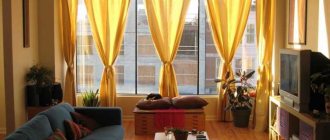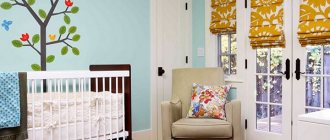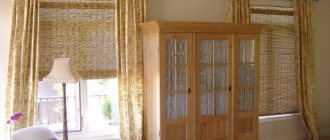Choosing curtains that do not allow light to pass through
Thick curtains that do not allow light to pass through are among the most popular and sought-after curtain models. If we turn to the origins of the word “curtain”, translated from French the word “porte” means “door”. Given the constantly changing weather in France, curtains were hung in the aisles as an additional protective layer between the street and the room. In the modern world, thick curtains not only block extraneous sounds and light and are placed on window openings, but also serve as a decorative element of the interior.
What are they?
Light-protective fabrics are divided into 2 types, depending on light transmission. What are curtains that block light called? Blackout blocks light completely, 100%. Dimout partially delays the penetration of light, by 80-99%.
Manufactured using special technology, they absorb 90-100% of sunlight and leave the room as dark as possible.
In practice, the term blackout is used for both options. Absolute darkness is not always necessary. If you go to work in the morning, it is advisable to recognize that morning has come. And in the nursery it is worth leaving a little light so that the crib with the baby can be seen.
Attention! Blackout curtains are made from three layers. The first one on the window side is reflective and white. In the middle there is a dense fabric that blocks the light flux, then an inner layer that performs a decorative function.
Once you understand the desired effect, you can begin choosing materials. High or medium density fabrics completely block light. They are sewn using various materials:
- Velvet. Soft, dense material with short pile on the front side. Able to protect from sunlight and drafts;
- Thick silk. Does not wrinkle, forms voluminous folds;
- Velveteen. Easily draped, does not wrinkle;
- Wool. Has a sound insulation effect;
- Tapestry. Dense, heavy fabric, suitable for curtains or woven blinds;
- Blackout is an impermeable synthetic fabric treated with multiple layers of acrylic foam. The base is polyester fibers. Use alone or in combination with other fabrics.
Their application has become very wide.
They are now used in both residential premises and offices. In addition, damask, linen, taffeta, satin, brocade, and moire are used in the interior. Each fabric gives a special touch to the interior.
How to choose good curtains
Despite the decorative component, blackout curtains perform a number of functions:
- Prevent the penetration of extraneous sounds from the streets (the hum of voices, cars and other sounds);
- Preservation of heat in the room, preventing cold air from entering through the gaps between the window opening and the window frame;
- They protect the owners of the house from prying eyes (which is especially important in private houses with windows facing the street or on the first floors of multi-story buildings);
- Allows you to regulate the flow of natural light entering the room.
Note. In the evening, when the light is on in the room, from the street you can always clearly see what is happening inside the house. Therefore, the thicker the curtains, the less chance that the curious will be left with a “nose”.
However, the question of which curtains to choose needs to be better understood, since in addition to the types of material for curtains, it is necessary to decide which models to choose that do not allow light to pass through?
What is blackout and its advantages
Light-protective curtains are made on the basis of a special fabric - blackout. It is a single or double satin weave material made from flame retardant polyester fiber.
The Finns are considered the inventors of this wonderful material.
The obvious advantages of blackout curtains are:
- shade the room from the sun;
- durability and long lines of use;
- do not burn out;
- do not shed;
- dense;
- drape well and do not wrinkle;
- heat resistant;
- protect not only from sunlight, but also from heat;
- easy to care for;
- hypoallergenic;
- keep their shape well;
- improve sound insulation of the room;
- lend themselves well to cutting and sewing.
Due to their properties and variety of shapes, colors and types, such curtains can be hung in any room. They are perfect for a child's room, since they do not emit toxic substances, and due to their increased fire safety properties (blackout does not burn, but melts), they are an ideal option for the kitchen.
Textile version of sun curtains
Varieties of this fabric differ in density, level of light transmission, color range, and texture. Blackout curtains are not necessarily plain; they can be decorated with a wide variety of patterns. And the fact that they do not let light through does not mean that these curtains exist only in black or other dark shades. You may be surprised, but this fabric comes in almost every color palette, including white, cream, and pastel colors.
Since blackout is a dense material, only curtains are made from it. An interesting fact remains that the fabrics from which blackout is made are actually thin, but thanks to the special technology of weaving threads, the result is a very dense blackout material.
When it comes to density, there are several options:
- thick three-layer curtains that practically do not allow light and heat to pass through;
- two-layer blackout. It can be used both for sewing lighter curtains and as a backing for curtains made of another fabric.
Regarding design, they can be monochromatic, in drawings or even in the form of photo printing, or imitate the texture of silk or satin.
According to many reviews, the highest quality blackouts are produced in Belgium, Finland, and Germany.
As noted earlier, blackout can be used both for sewing curtains and as a lining for curtains made of other fabrics. It should be noted that it is better to choose curtains made from natural fabrics (cotton, linen), as well as taffeta and viscose, with such a lining. It will improve the reflective properties of the curtains, and also protect them from premature fading and wear.
If you imagined solar curtains only in black or gray shades, this myth has been debunked. These curtains are made in a wide variety of colors.
Types of thick curtains
- Rolled. Based on the name, they are fabric wound on a small shaft.
- Classic. Classic curtains are a paradise for an interior designer, because you can play with such curtains, add accessories, and create intricate folds.
- Japanese. Along with Roman and rolled, they are a straight cut.
- Blinds. They can be either metal or fabric. The latter option is more popular for use in office premises than at home.
- Scalloped. Invented in Austria, where the material is tied with cords and threaded into rings, forming small puffs at the bottom.
Cotton curtains
Cotton material differs from most analogues in its high strength and environmental friendliness. They can be plain or with a pattern applied to the surface by printing or painting. Despite its widespread use, cotton has a number of disadvantages, namely fading and loss of color over time. It is not recommended to use cotton curtains on windows on the west and south sides of the house in strong sunlight, because the material, despite its strength and wear resistance, is weak to UV rays. With prolonged contact with sunlight, the area exposed to ultraviolet radiation begins to fade.
It is possible to avoid this drawback by making a special lining, which will not only protect the material from fading, but also serve as an additional layer between the sun’s UV rays and the room. Loss of color over time can be prevented if you use delicate laundry with appropriate powders and conditioners. The delicate washing mode implies not only cool water, but also a minimum speed, so as not to damage the fabric during the washing process.
Helpful advice! When hanging on a line to dry, cotton curtains should be straightened to reduce ironing problems. It is best to iron small folds of wrinkled fabric using the steam mode.
Linen curtains
Unlike cotton, linen is a stiffer material, due to which the chance of tearing the fabric is zero. Thick linen curtains are perfect for the reception room, guest room, children's room and master bedroom. Despite the increased level of strength and wear resistance, linen curtains wrinkle more than cotton curtains. Therefore, when ironing the material, you should choose a mode with steam humidification, which will allow thick curtains that do not let in light to be brought into proper shape in a short time.
Helpful advice! Linen curtains should be washed at a minimum degree - no more than 30 o C.
What are blackout curtains
These are curtains that cut off light by 90-100%. Such curtains are indispensable in home theaters; bedrooms and children's rooms facing well-lit streets; in northern latitudes during “white nights” and other similar situations.
Blackout curtains in the interior
1 of 13
Unlike conventional curtain fabrics, blackout consists of three layers:
- the outer one is white and reflects the sun's rays;
- medium - the thickest and densest, retains the remaining light;
- internal - decorative, made from different materials, including textured or with patterns.
Such curtains will blend harmoniously with the space without contrasting with the surrounding environment.
Impregnation and acrylic foam provide additional durability and shading. The material is dense and smooth to the touch (the decorative side can be textured). Three layers are clearly visible at the incision site. If you look through the fabric at a window or lamp, no light will pass through. By this feature, blackout can be easily distinguished from other materials.
Blackout fabric is made using special technology
Types of curtains that do not allow light to pass through
Often there is a need to significantly reduce the sunlight emanating from a window or even block it completely. There are a variety of reasons for this:
- sun glare reflected on the TV or computer screen
- white nights make it difficult to sleep
— advertising structures or bright lanterns shine directly into your window at night
— you made a home theater at home using a projector and want to watch movies during the day
To solve this problem, the market offers three types of curtains: blackout, dimout and simply thick curtains.
Blackout curtains block out almost 100% of light. These curtains are ideal for home cinema, with their help you can enjoy movies even on a sunny day. If you want curtains to protect against light pollution at night (prevents you from falling asleep), then it’s better to take a closer look at other options, since such thick curtains, although they will help you sleep, will make it very difficult for you to wake up in the morning (read about the circadian rhythm).
Dimout curtains block about 80% of the light and are good for protecting against bright lights or sun glare on the screen. Such fabric is cheaper than blackout, and often unscrupulous sellers sell just such fabrics under the guise of blackout. It’s very easy to check that you’re not being deceived: turn on the flashlight on your phone and hold it against the fabric; if the light is dim but visible, then it’s a dimout. Dimout curtains are an ideal option for the bedroom.
Thick curtains are not able to protect against bright light; they are designed to muffle it and decorate the room. Therefore, they are best suited for the living room (unless, of course, you have installed a home theater in it).
Source
Combinations
To reduce light transmission, curtains are combined. The following types of combinations are used.
- Thick curtains and tulle. Collectively thicker than one curtain. Retains 40% - 60% of light (depending on the material and density).
- Curtains and roller blinds. Provide protection from bright light in different conditions. Rolls provide almost complete darkness. Curtains let in more light, making them suitable for cloudy days.
- Blackout and roller blinds. Blackout is suitable for summer as it does not allow heat to pass through. Roller blinds - for other seasons or cool weather.
Why do you need protection from light?
Light-blocking curtains can be useful in the following cases.
- If the bedroom windows face east, and the morning sun wakes up the owners of the house long before the alarm clock. If you live in northern latitudes, and a day that lasts six months does not allow you to get enough sleep. In conference rooms and business centers, where presentations are accompanied by slides or films. In schools, colleges and universities, if educational films are shown during a lesson or lecture. In medical institutions where complete darkness is required to make a diagnosis. In nightclubs and cinemas. In photo laboratories, so as not to expose the film or print high-quality photographs.
When you don't need to change
The light transmission of curtains is not increased in the following situations.
- When you need light to enter the room. For example, due to interior features.
- If the main function of curtains is not to block the sun's rays, but to protect the room from the views of strangers.
- Due to the peculiarities of the pattern of the curtains. Some patterns only reveal themselves when the sun's rays shine through.
- In low light conditions. If the apartment is located on the ground floor or near trees, light has difficulty penetrating there. In this case, the curtains should have more light transmittance.
The permeability of curtains determines how much light the curtain lets in. It is increased when complete darkness or protection from sunlight is needed (for example, if the TV screen or computer display is reflective). Based on light transmission, curtains are divided into blackout, dimout, and thick. The first do not transmit light at all. The latter retain 40% - 50%.
Requirements for thick curtains that do not allow light to pass through
All curtains perform three main tasks:
- Protect from light; Eliminate visibility from the street; Decorate the premises.
In addition, curtains can relieve the room from drafts and protect from city noise.
There are also additional requirements for curtains in different rooms.
- In the dining room or kitchen, products should not absorb odors, and caring for them should not be difficult. Ideal curtains are easy to wash and have the ability to adjust the height. The best colors that increase appetite are beige, apricot, with orange-red details. Night curtains for the living room are chosen taking into account the wishes of all household members. As a rule, the consensus is products in muted tones that bring a calm atmosphere to the home. Bright drawings and prints are appropriate in the nursery. Non-marking curtains should be firmly secured to the eaves. Preference should be given to lightweight natural fabrics that do not collect dust. In the bedroom, more than in any other room, you should think about light protection. The vital hormone melatonin, which is responsible for sleep and wakefulness, can only be produced in the dark. From the color scheme, it is better to give preference to calm, warm tones.
Which curtains retain heat best?
The main place through which heat “escapes” is the window. Therefore, it is so important to take care not only of decoration, but also of additional thermal insulation of windows.
Double pleated blinds
Such curtains in their structure resemble a honeycomb. They do their job perfectly at any time of the year. It is recommended to install them on skylights, as they are the most vulnerable to heat loss. In winter, pleated blinds will ensure a comfortable room temperature even with low heating power.
It is also worth noting that the double honeycomb texture is durable and waterproof. This option will darken the room as much as possible, allows air to pass through well and has excellent energy-saving properties.
Roman curtains
They consist of many folds, so heat loss through plastic windows is protected. For winter, Roman blinds are more preferable than other classic window design options. This is due to the fact that the curtains will only cover the window opening, and not the radiators, which must be completely open for better heat distribution throughout the room.
Roman blinds are made of fabric that has good throughput, so it will not lead to the formation of excess moisture on the windows. We recommend choosing high-quality fabrics rather than skimping on materials.
If you want to improve the effectiveness of Roman blinds, we recommend choosing an option with a darkening aluminum “blackout” coating. In summer, such a design will help relieve the room from overheating, and in winter, the curtain will provide optimal thermal insulation, reflecting the heat of the room inside.
In winter, Roman blinds should be closed tightly at night to prevent heat from escaping. If the sun shines during the day, raise them so that the room can warm up naturally.
Fabric curtains and blinds
Many people prefer a classic style in the interior and are in no hurry to part with beautiful, cozy velvet curtains. The designers came up with an excellent solution - to use a duet in the form of curtains and blinds on the window. This composition is not only aesthetic, but also practical.
Experts do not recommend installing any additional barriers to the spread of heat from the battery. As for long curtains, they do have a negative impact on the overall climate in the room. If you use thick curtains and blinds in tandem, then the so-called distribution of roles occurs. That is, the roller shutter protects the double-glazed window, and the duties of the curtain include protecting the side of the windows.
In winter, it is better to give preference to light and light fabrics. Avoid dense materials. If you think that this solution does not fit into the overall interior of the room, then choose roller blinds made of light fabric, and let the curtains be darker.
Roller blinds
They are a real salvation from overheating in the summer when intense sunlight enters the room. However, experts say that this model of curtains is also energy saving.
Thermal curtains are made of dense high-quality material, and therefore brilliantly protect the room from heat loss. However, you should not choose a fabric that does not allow air to pass through at all. If there is not good ventilation, this can subsequently lead to the formation of condensation on the double-glazed windows.
In many rooms, most of the heat “exits” through the windows in winter. Therefore, these places should be provided with additional protection using a shielding system. Typical curtains are absolutely not suitable for this. But a roller shutter with an additional rubber layer or aluminum coating will cope with this task brilliantly. A roller blind will not only darken the living space, but will also become a reliable assistant in terms of general thermal insulation in the home.
Light-blocking fabrics
Depending on the purpose of the room, it is recommended to sew light-protective curtains for windows from the following fabrics.
Living room
- Velvet. Ceremonial, regal material with short and very dense pile on the front surface. Produced from cotton, silk threads and viscose. Creates an interesting play of light and shadow, changing its appearance depending on the viewing angle. Requires careful cutting: in all parts the pile is placed in the same direction. Perfectly protects the room from drafts and sunlight. Corduroy is a soft and dense material with large or small rib. Draps well and can withstand complex cuts.
- Dense silk is one of the most durable natural fabrics, almost does not wrinkle, and forms beautiful folds. The lining adds additional volume and light protection. Tapestry is a fabric produced by decorative weaving that contains patterns or ornaments. Good for heavy curtains or woven blinds. Reliably darkens the room. Wool, a material obtained from sheep yarn, is rarely found in interiors. Protects not only from light and drafts, but also from street noise.
- Moire is a dense fabric with a spectacular, iridescent sheen. It makes original blinds. Brocade is a heavy silk-based material. It uses metal threads to create designs. The pattern resembles luxurious embroidery. Brocade makes magnificent floor-length curtains with numerous folds and flounces. Scraps of thread may protrude on the wrong side, so it is recommended to provide the product with a lining. Damask (damask) is a dense silk fabric of jacquard weave with the inclusion of wool or cotton threads. Forms matte and shiny patterns. Good for blinds and drapes.
- Satin - obtained by special weaving of twisted fibers. The composition may contain silk mixed with cotton or linen. The material has a spectacularly shiny front surface and a matte back. Draps wonderfully and protects well from light. Taffeta is a shiny fabric made from acetate and silk. It is somewhat rigid, but retains its shape well. Taffeta makes lush and luxurious curtains. Blackout is a synthetic fabric consisting of polyester fibers. A recognized leader among fabrics that do not transmit light. Provides almost 100% light protection. It is processed with two or three layers of acrylic foam and is fire resistant. Three-layer fabrics are used to make roller blinds, two-layer fabrics are used for lining.
Kitchen, dining room
- Canvas is a material with a rough texture for special, brutal dining room interiors. It is durable and cheap. Good for curtains and blinds. Cotton with special water- and grease-repellent treatment. Natural material, unfortunately, quickly fades in the sun. High density linen. The material is characterized by increased rigidity and holds ironed folds well. Eco-friendly, extremely durable and wear-resistant fabric. May fade in the sun. It wrinkles quickly, but can also be smoothed out well with a hot iron. Synthetic fabrics based on polyester and acetate. Elastic, water and fire resistant, characterized by high strength and durability. Artificial fabrics are made of viscose. The products are pleasant to the touch, soft, and breathable.
Bedroom
- Cotton – printed or plain-dyed. Light transmission is reduced by thick lining. Not recommended for use on south and south-west windows. Prolonged exposure to the sun causes the material to fade. Thick silk. Synthetic and artificial fabrics. Blackout.
The light transmittance of curtains is calculated as a percentage. What does it mean, for example, that blackout curtains provide 100% blackout, and dim-out curtains block sunlight from 80%.
Children's
- Cotton with a bright print, lined. Synthetic fabrics. Viscose.
Light transmittance of curtains
Each fabric will have different light transmittance, and it also depends on the color of the fabric and the design of the curtains. That's why designers warn about the difficulties with choosing curtains when creating a new interior. But still, you shouldn’t be afraid, especially if everything has already been thought out. And if not, then you just need to do it right! There are modern technologies that make it possible to create curtains that will almost completely protect the room from light and also add a special “zest” to the interior.
But the problem is that they may not suit every interior style, and they can be very expensive. Regular curtains can be almost as effective, they just differ in some properties, which is a factor in choosing between the variety of types of curtains. What is more important here is the taste of the owner, the features of the interior, and the necessary “work” for the curtains. So you shouldn’t immediately put classic curtains on the shelf.
Types of blackout curtains
Both classic and modern types of curtains cope with the task of providing light protection.
- Classic. Products with vertical folds. The most popular curtains. They can be secured with loops or fabric ties. They can be put on the cornice rod, attached to the latter using a lambrequin frill or plastic (metal) grommet rings. Roman or Romanesque. The curtain fabric folds in steps, forming interesting waves on the folds. Rolled. The products are wound on a fixed shaft. A special system allows you to open the window to the desired height and regulate the incoming light flow. Roller blinds are often opened electrically. Austrian (scalloped) - form horizontal folds. They are lifted using cords secured from the inside. French. Looks better on large windows. They represent many narrow festoons assembled vertically. The canvas can be raised to the required height or lowered completely.
- Japanese - smooth canvases with rigid inserts at the top and bottom of the products. They are mixed along the window along a special cornice. Move apart from the center or to one side. Blinds – effectively protect from light. Can be made of fabric or other materials. In home interiors, vertical structures are more common than horizontal ones.
Types of curtains
Japanese
The canvases are smooth, the inserts at the bottom and top are rigid. Thanks to them, the curtains move smoothly along the window. The sliding is central or one-sided.
Classic
They form vertical folds when moving across the window. You can make a variety of folds, there are a lot of fastenings. These curtains are very popular now.
Rolled
They look like a long sheet of cloth that is wound around a shaft. There is a convenient height adjustment mechanism. They go down to the level that is comfortable for you. They are fixed there. During the day, the lighting in the room is regulated. Light-proof roller blinds for plastic windows are also made from Black-out light-protective fabric. Thanks to this, the room is completely darkened and you can comfortably work in the evening on a large computer screen, watch your favorite movie on a large TV screen or play cartoons or films on a projector. The canvas is also made from wrinkle-resistant material. It has antistatic, antibacterial and dust-repellent effects. Easy to wash. Don't know how to quickly and effectively remove stains? The stain remover will help remove heavy stains. Saturate a napkin with it and wipe the area.
Roman
They are also called Romanesque. These are canvases, when you lift them you will see horizontal assemblies. They overlap one another. There are 2 types of lifting mechanisms: When lifting, the folds will be at the bottom of the curtain, and at the top it will be flat. Folds from bottom to top. These curtains are more expensive. When folded, the pattern of the curtains forms beautiful waves. How much the room will be illuminated depends, in addition to the rise, on the type of fabric. To wash, the curtains are removed along with the loops and cords and separated from the Velcro tape. Let dry and attach as well.
Austrian
Austrian or scalloped are horizontal folds in the material. They are tied with cords. They pass from the inside out through rings or loops. When lowered, the curtains are straight. There are only a few puffs at the bottom or small folds. French Gathered along the entire length. Narrow scallops are obtained vertically. The canvases can be made raised or lowered.
Blinds
Blinds effectively regulate the light in a room. There are vertical and horizontal. The plates are also called lamellas. They are made from different materials. Popular: fabric, metal, wood or plastic. Blinds hang either alone on the windows or they are combined with lambrequins, with curtains in soft folds. Tip: Install blinds as you see fit. You can do it classically in front of the window, in the window opening or behind the window.
From us you can order custom-made blackout curtains, and Lazurnaya Tatyana's Interior Design Studio will help you complete a complete interior design project.
Manufacturers
Light-protective curtains are produced by domestic and foreign companies.
- Master (Russia) produces light-protective roller blinds from fabric canvas and blackout. Photo printing techniques are widely used. Lifting mechanisms made in Holland. The electric drive is equipped with a remote control. Velux (Denmark) specializes in the production of skylights and Siesta blackout curtains. Canvases can be used not only in attics, but also in ordinary bedrooms, living rooms or children's rooms. "Siesta" darkens the room 100%. The company's assortment includes 40 colors of this model. The light-proof curtain for the window is made of polyester. It is dirt resistant and easy to maintain. The aluminum coating on the back of the model provides good thermal protection. The simple design can be installed in a few minutes (Pick&Click system).
- Roto (Germany) produces RotoStandart roller blinds with an aluminum layer that reflects heat and light. The products are mounted on the frame without a gap, which enhances the light-protective properties of the models. The curtains rise smoothly and are fixed in three positions. The canvas is impregnated with a substance that provides resistance to light and ease of maintenance. RotoStandart is made from 3 materials, in 37 different colors. The Turkish company Apolena produces light-protective curtains for the living room and bedroom. The collection includes plain products and models with patterns of rich colors, made of 100% polyester.
Light-protective curtains calm you down and give you a long, sound sleep. They create a romantic atmosphere and prevent glare from TVs and monitors. This is the textile item that takes care of our well-being and comfort.
Photo gallery
Classic
To the children's room
Roman blackout blinds
Pleated
3D photo printing
Lightproof curtain fabric
Printed blackout
Roller blinds blackout
Roman blackout
